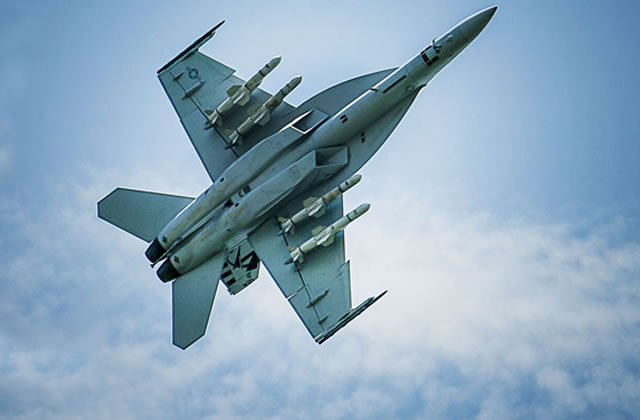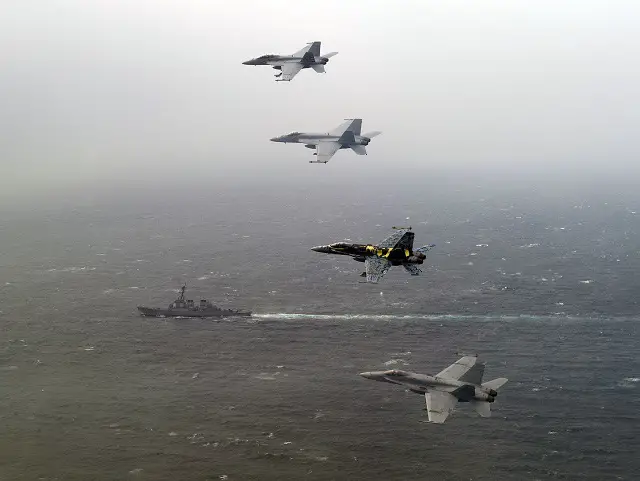|
|
| a |
Naval Defense Industry News - USA |
| |
|
| |
| |
U.S.
Navy Orders 46 Electronic Warfare Jammers for F/A-18E/F Super Hornet
& F/A-18C/D Hornet
|
| |
Electronic
warfare (EW) experts at the Exelis Inc. in Clifton, N.J., will provide
the U.S. Navy with 46 sophisticated EW systems designed to protect Navy
combat aircraft from incoming radar-guided missiles. Officials of the
Naval Air Systems Command at Patuxent River Naval Air Station, Md.,
have announced a $97.3 million contract to Exelis to build 46 full-rate
production lot XII AN/ALQ-214(V)4/5 integrated defensive electronic
countermeasures airborne jammer systems for the Navy's F/A-18C/D and
F/A-18E/F Hornet and Super Hornet carrier-based strike fighters. |
|

An F/A-18F Super Hornet from U.S. Navy Strike Test VX-23 in flight with
four Boeing built Harpoon anti-ship missiles under its wings. Picture:
Boeing
|
|
The AN/ALQ-214(V)4/5 is an electronic jammer component
of the integrated defensive electronic counter measures system (IDECM),
which comes to the Navy from a joint venture of Exelis and BAE Systems.
It protects Navy fighter-bombers from radar-guided surface-to-air and
air-to-air missiles by jamming the missile guidance systems.
This effort also includes the repair of test assets and field support
for the AN/ALQ-214(V)4/5. Exelis is a wholly owned subsidiary of Harris
Corp. in Melbourne, Fla.
The ALQ-214 component of the IDECM EW system has been delivered to the
Navy as well as to the Royal Australian Air Force for contemporary versions
of the Boeing F/A-18 fighter-bomber. The system blends sensitive receivers
and active countermeasures to form an electronic shield around the aircraft,
Exelis officials say.
|
|

ARABIAN GULF (Feb. 25, 2012) From top; an F/A-18F Super Hornet assigned
to Strike Fighter Squadron (VFA) 22, flown by Lt. Cmdr. Warren Tomlinson
and Lt. j.g. Josh Raymond, an F/A-18E Super Hornet assigned to Strike
Fighter Squadron (VFA) 81 flown by Lt. Daniel Solfelt, an F/A-18C Hornet
assigned to Strike Fighter Squadron (VFA) 113, flown by Cmdr. Craig
Sicola, and an F/A-18C Hornet assigned to Strike Fighter Squadron (VFA)
25 flown by Lt. Taylor Hesse, fly over the Arleigh Burke-class guided
missile destroyer USS John Paul Jones during a mission flown from the
Nimitz-class aircraft carrier USS Carl Vinson (CVN 70). Carl Vinson
and CVW 17 are deployed to the U.S. 5th Fleet area of responsibility.
(U.S. Navy photo by Mass Communication Specialist 2nd Class James R.
Evans/Released)
|
|
The RF countermeasure system engages incoming missiles
autonomously with a series of measures designed to protect the aircraft
from detection.
The AN/ALQ-214(V)4 a smaller and lighter version of its predecessors,
and has an open-architecture design that is ready for integration on
several different kinds of aircraft.
The system is designed to counter radar-guided anti-aircraft missiles
with electronic countermeasures (ECM) techniques that deny, disrupt,
delay, and degrade the enemy missile launch and engagement sequence.
The system identifies, ranks, and counters incoming missiles, and displays
engagements to the flight crew for situational awareness.
|